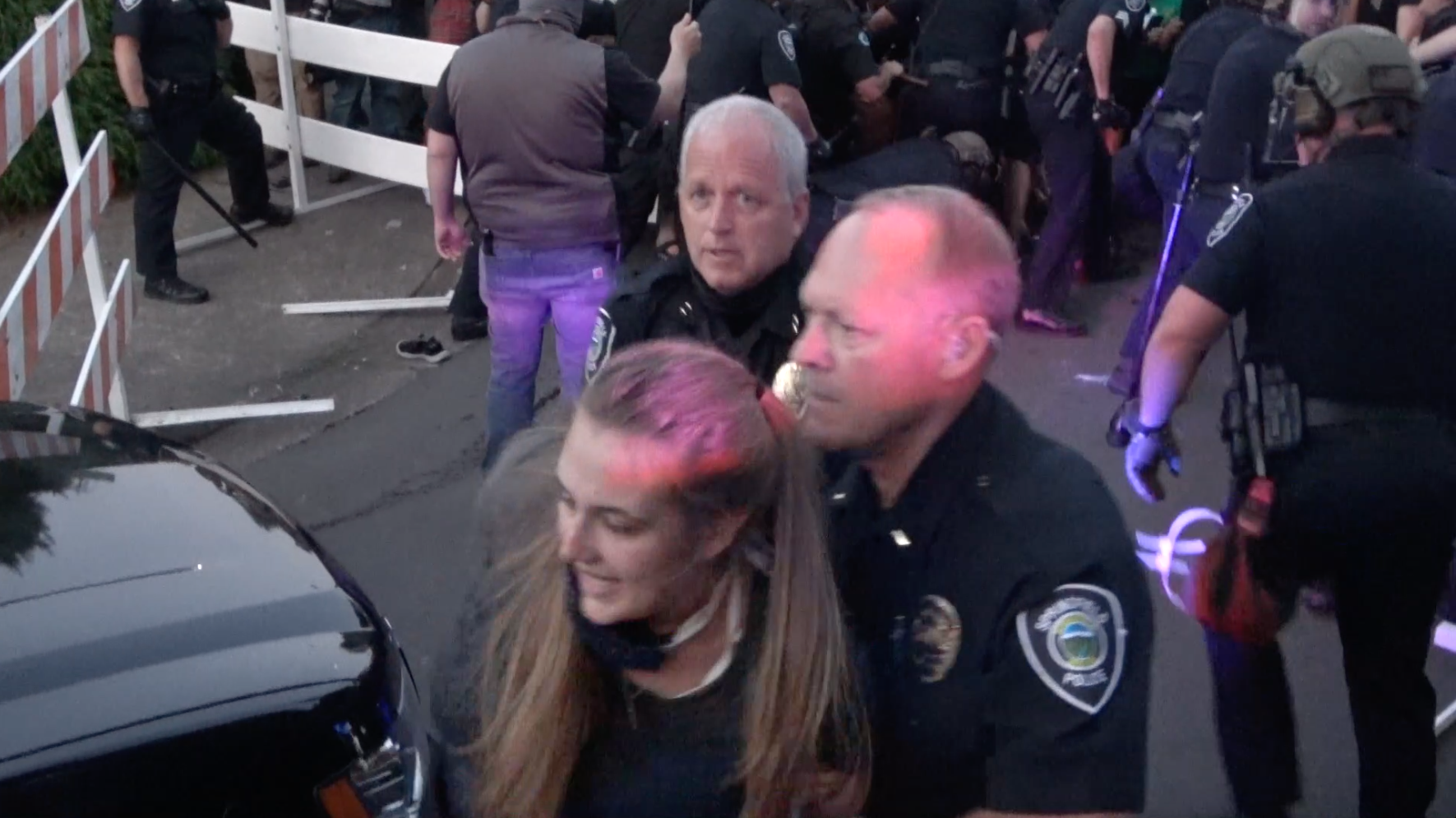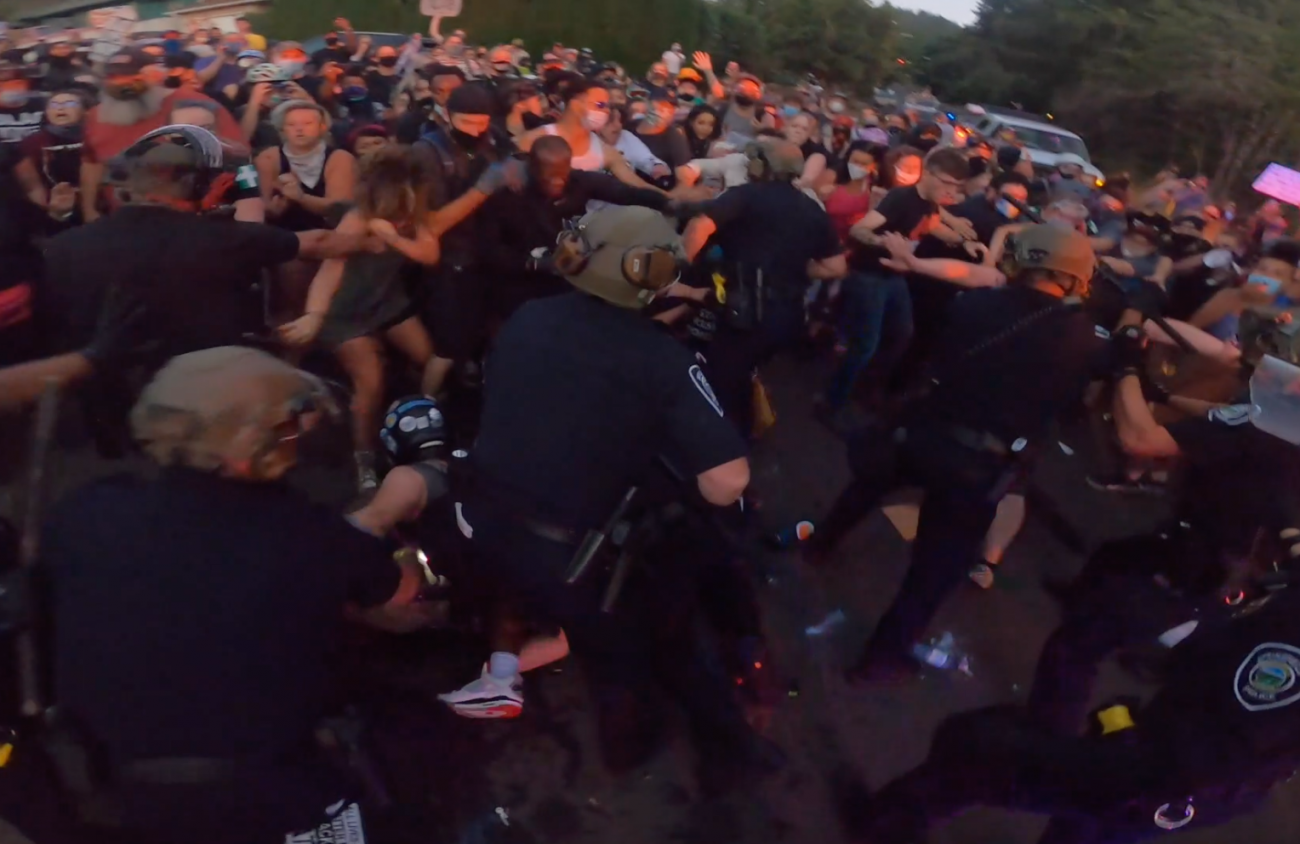On July 29, in the midst of Black Lives Matter-related protests, the group Black Unity organized a protest in the Thurston neighborhood. Like many protests throughout the U.S., it was live-streamed and clips were shared on social media.
And the police response to it provoked public outrage.
The aftermath of the protest resulted in several months of the public attending Springfield City Council meetings, calling for increased police accountability and reform. And more recently Black Unity protesters and the Civil Liberties Defense Center (CLDC) have filed a civil rights violation lawsuit against the city, police department and named and unnamed officers.
After months of interviews and research, the city of Springfield released external investigator Rick Braziel’s report on the Springfield Police Department’s response to Black Unity’s protest in the Thurston neighborhood. The report cost the city $31,250, according to city spokesperson Amber Fossen.
Braziel offers 38 recommendations to the police department, some of which include calls for increased internal investigations on use of force, a need for better on-the-ground commanding and transparency. In a press release, the city says it’s learning from the event, has already adopted some changes and claims the report shows there was no wrongdoing or collusion with counter-protesters.
“When we got his report we went through each and every one of the recommendations to see one, have we already done this or planning to do it, or is it feasible and reasonable,” SPD Chief Rick Lewis tells Eugene Weekly. “You have to weigh that against how much manpower you have in a particular agency. Some of the recommendations there were out of our control or were just recommendations for future considerations.”
On Oct. 2, the city of Springfield announced that it had enlisted Braziel to conduct an external investigation of the July 29 Black Unity protest through the Thurston neighborhood. Braziel worked for the Sacramento Police Department for more than 33 years and now conducts reviews of police response.
The protest happened during the peak of ongoing national protests over the Minneapolis police officer who killed George Floyd after kneeling on his neck for about nine minutes. Black Unity planned the protest in the Thurston area after a resident of the area shared an image of a neighbor’s noose decoration on social media.
After the July 29 protest, videos of SPD’s use of force on protesters and of friendly chit-chat with counter-protesters, took social media by storm. The videos showed a male police officer punching a female protester in the face at a barrier as he struggled to possess his baton, another instance where an officer kneeled on the lower back of protester Tyshawn Ford as they arrested him and a police officer informing counter-protesters where the protest was.
Braziel writes SPD was justified in using a Taser set on stun mode to drive people away from the barrier while arresting Tyshawn Ford. However, he says SPD should investigate whether use of force was justified when a police officer partially kneeled on Ford. He says in the report that the police officer who punched a protester in the face during a struggle over a baton was using “reasonable” force to secure his weapon.
The report says that SPD should adopt a policy that requires a review of force when it results in an injury requiring medical attention for a suspect or officer and if it generates public interest. “The number of uses of force, variety in types of use, number of protesters force was used against, the number of injuries, and high public interest should have triggered a comprehensive investigation review by the department or by an outside agency.”
He later writes that SPD’s supervisors who conduct administrative interviews need an update in conducting internal investigations. “Some of the employee interviews conducted by SPD supervisors contained leading questions, personal input, rationalizations and justifications,” he says. “At times, the interviewers identified themselves as being a witness to the conduct in question which helped the officers answer the question.”
In the report, Braziel says transparency, neutrality and accountability must be a priority for the city to ensure public trust. “Public trust, particularly in demonstrations, requires that SPD officers remain neutral and unbiased in their interactions with protesters and the community,” he wrote. “The use of force and complaint investigative processes must be independent, above reproach and unbiased. The availability of resources must never compromise the integrity of an investigation.”
According to body cam footage obtained by CLDC for its federal lawsuit against the city of Springfield, plaintiffs argue some police officers were not neutral during the protest. Officer D.L. Casarez used profane comments to others about the protesters, according to the filing. While pointing at a Black Unity supporter, he said “I want that fat bitch to go to jail.” After police arrested Ford, Casarez said, “These fuckers, I wanna lock even more of ‘em up.”
Braziel didn’t mention this incident in his report but does recommend that police officers should remain fair and respectful when communicating with the community. He said most officers were appropriate but others were “observed speaking cordially with counter-protesters while not speaking with, or in a couple incidents speaking rudely, to peaceful protest supporters.”
He adds, “The disparity in communication demeanor demonstrated a lack of impartiality by some of the SPD officers.”
Braziel says in his report that Springfield police must adopt a culture of improvements, such as seeking out best practices and lessons. He added that this requires that the department establish a self-critical culture and process that treats the employees fairly while holding the same standard without favoritism or bias.
Braziel also recommended that SPD should clearly identify all police officers at protests. On July 29, and at other protests in Springfield, police officers dressed in civilian clothes while videotaping. He said protesters thought they were media granted special access to be behind the barrier where protesters and police clashed. “And still others speculated that the two officers were part of the counter-protest group and the police were collaborating and supporting the counter-protesters,” he adds.
One of Braziel’s recommendations was for SPD to improve its relationship with local media to address misinformation. Chief Lewis tells EW that after live streamer footage was shared on social media, he realized SPD should have shared its own footage.
Braziel recommended that SPD participate in Incident Command System training since the police had several mistakes in commanding at the Thurston event. This includes having had the chief on the ground as an incident commander. Braziel says this compromises the chief’s ability to independently review complaints and uses of force by police officers and advise the city manager.
According to a collection of footage from live streamers and SPD’s undercover police officers, Lewis participated in multiple arrests.
Lewis says that “the chief of police will probably not be out there in the future.”

At a March 8 press conference where the CLDC and Black Unity protesters announced their federal lawsuit against Springfield, CLDC Executive Director Lauren Regan had said she wasn’t confident in what Braziel’s report would say. “Whenever the police are policing the police, we know that they’re not going to actually call each other out — they’re on the same team,” she said. “We expect the Braziel report to be a whitewash and we would never rely on that for this case.”
Lewis says after the July 29 Thurston protest, Lewis and other police officials analyzed their response and came to some of the same conclusions Braziel provided.
Lewis says SPD had plans to run through protest training before the George Floyd protests started. He says because of the 2020 presidential elections, SPD had planned in fall 2019 to run through the “Mobile Field Force Training” during spring or summer 2020. “We had it on our plate. We typically use the Oregon State Police to assist us with that training,” he says. “No one was going to do training in the COVID environment so that in-person training just stopped.”
He adds that the SPD officers will attend online de-escalation training and other in-person training when allowed.
A March 25 press release from city officials said the report showed there was no wrongdoing or colluding with counter-protesters. Springfield’s Mayor Sean VanGordon said in the same press release that the city is learning from the July 29 event. “Our growth is possible thanks to the many community members who participated in this assessment and offered their voice so that we can pause, reflect and implement change,” he says.
Click here to watch SPD’s video of the July 29 Thurston protest, which was used for Braziel’s report. City officials say the video includes footage from SPD and live streamers. Viewer discretion is advised.
To read the report in its entirety, click here.
